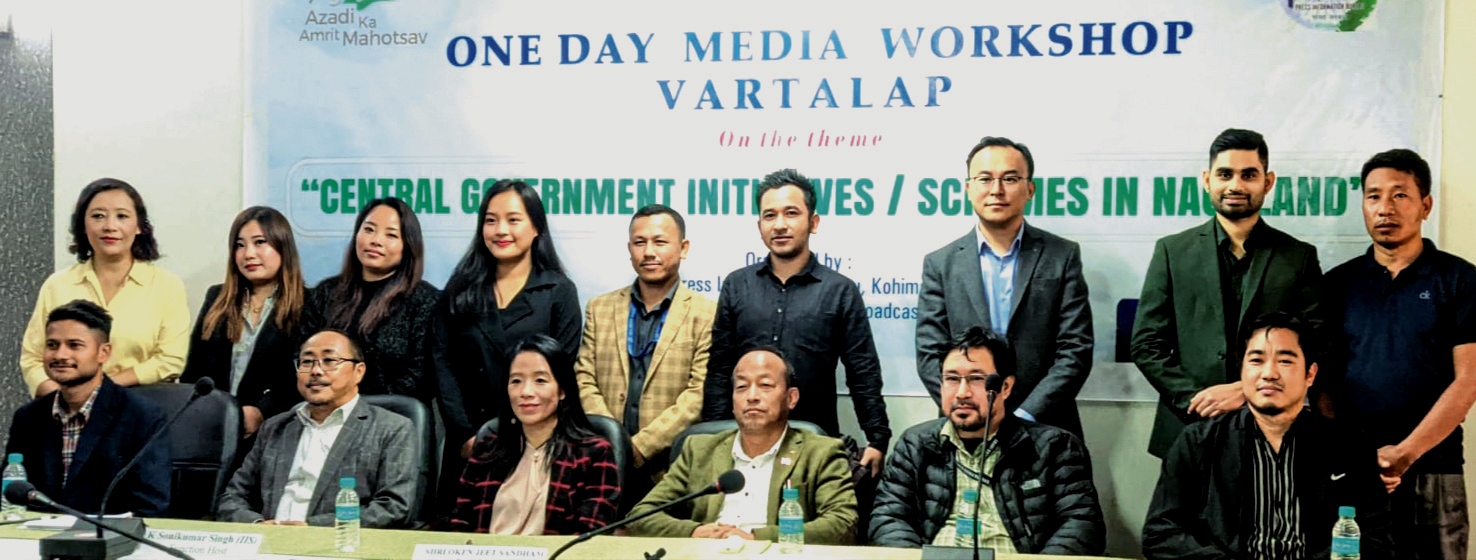Share

KOHIMA — A one-day media workshop titled 'Vatalap' (discussion) was held in Kohima on Thursday, where journalists gathered to discuss ‘Central government initiatives/schemes in Nagaland’.
The event was organised by the Press and Information Bureau (PIB), Ministry of Information and Broadcasting. The keynote address on the occasion was delivered by K Sonikumar Singh, assistant director, PIB Kohima.
Thavaseelan K, principal director of School Education, who attended the event as the chief guest, acknowledged a prevailing lack of awareness about centrally and state-funded schemes in the northeastern region of India and highlighted the need for more sensitisation sessions to bridge the communication gap and create awareness about the available programmes.
[bsa_pro_ad_space id=1]The chief guest also mentioned a lack of awareness in Nagaland about key schemes such as the Chief Minister Health Insurance Scheme and the Chief Minister's Micro Finance Initiative and urged the government to step up efforts to raise awareness and ensure that people can effectively access these programmes.
Oken Jeet Sandham, a senior journalist and the guest of honour at the event, emphasised the importance of helping citizens access the approximately 740 centrally sponsored schemes effectively. He noted that banks frequently request more documents than necessary from beneficiaries, making it difficult to apply for schemes, and suggested that bank representatives participate in awareness programmes in order to better understand their roles and responsibilities towards beneficiaries.
He highlighted the issue of reputable banks acting as impediments, preventing individuals from applying for the critical Pradhan Mantri Formalisation of Micro Food Processing Enterprises (PMFME) scheme.
Sani Pongen, an assistant engineer from School Education, shared valuable insights on 'One Nation, One Student ID’ and the key features of the National Education Policy (NEP) 2020.
Vedpal Singh, the principal chief conservator of Forest and Chief Wildlife Warden, shed light on the Forest (Conservation) Act of 1980 (FCA) during the event.
He explained that the act was enacted by the Government of India (GoI) to monitor and control the extensive diversion of forest lands by various states. Singh said that the act requires prior permission from the central government before diverting forest land for non-forestry purposes.
Furthermore, he said that the Government of Nagaland, in notification No. FOR-58/82 dated July 3, 1986, stated that the provisions of the FCA would only apply to ‘Government reserved forests and such other forests and wildlife sanctuaries under the control of the State Government’.
The Supreme Court of India expanded the scope of the act in 1996, encompassing all forest areas, with the definition of ‘forest’ aligning with its dictionary definition. According to Singh, this extension brought many private forests under the FCA's jurisdiction.
Singh said that this decision raised concerns that extending the act to private forests might infringe upon privileges granted under Article 371(A) of the Indian Constitution.
Nevertheless, Singh noted that FCA was never applied to private forest areas in the state since the state government did not modify the notification of July 3, 1986.
He went on to say that the Government of India recently amended the FCA to make it only apply to notified government forests, areas, and lands recorded as forests in government records after October 25, 1980. However, Nagaland lacks such government records to determine the status of the land.
Meanwhile, Singh claimed that the state is losing money by not applying for the Compensatory Afforestation Fund Management and Planning Authority (CAMPA).
Kunal Jha, the assistant manager at the Ministry of Tourism, provided an overview of tourism in Nagaland and emphasised the key tourist destinations, which include Dzükou Valley, Japfü Peak, Jotsoma, Khonoma, Kohima War Cemetery, Kisam Heritage Village, Puliebadze, Tribal Museum, and State Museum.
He emphasized the Unique Selling Points (USPs) that make Nagaland Tourism truly exceptional, such as the renowned Hornbill Festival, the magnificent Catholic Cathedral, enthralling opportunities for trekking and camping, the solemnity of the War Cemetery, and the delightful and diverse Naga Cuisine.
Jha reported that during the fiscal year 2021–22, Nagaland received a total of 24,294 visitors, including 23,968 domestic tourists and 326 foreign tourists.
[bsa_pro_ad_space id=1]In terms of development projects, Jha stated that 19 projects, both existing and proposed, have been identified as ‘investable projects’ for the upcoming Global Tourism Investors Summit in New Delhi. He revealed the completion of two projects under Swadesh Darshan 1.0 while updating the status of tourism development.
With a total funding of INR 195.50 crores, these projects involved the development of a tribal circuit at Peren—Kohima—Wokha and a similar initiative at Mokokchung—Tuengsang—Mon.
Additionally, Jha informed about the selection of Niuland and Chümoukedima for the implementation of Swadesh Darshan 2.0, with a sanctioned budget of INR 160 crores.
A construction project for a pilgrimage centre at Molungkimong—Noksen—Aizuto—Kohima—Vankhosung is ongoing under the PRASHAD scheme, with INR 25.26 crores in funding. Also, INR 18.18 crore has been awarded to a project under PRASHAD for a project in Zunheboto.
The special guest at the workshop was Vishü Rita Krocha, general secretary of the Kohima Press Club.
Also read: Celebrate Nagaland’s ancient tribal cultures & traditions, the Great Hornbill Festival